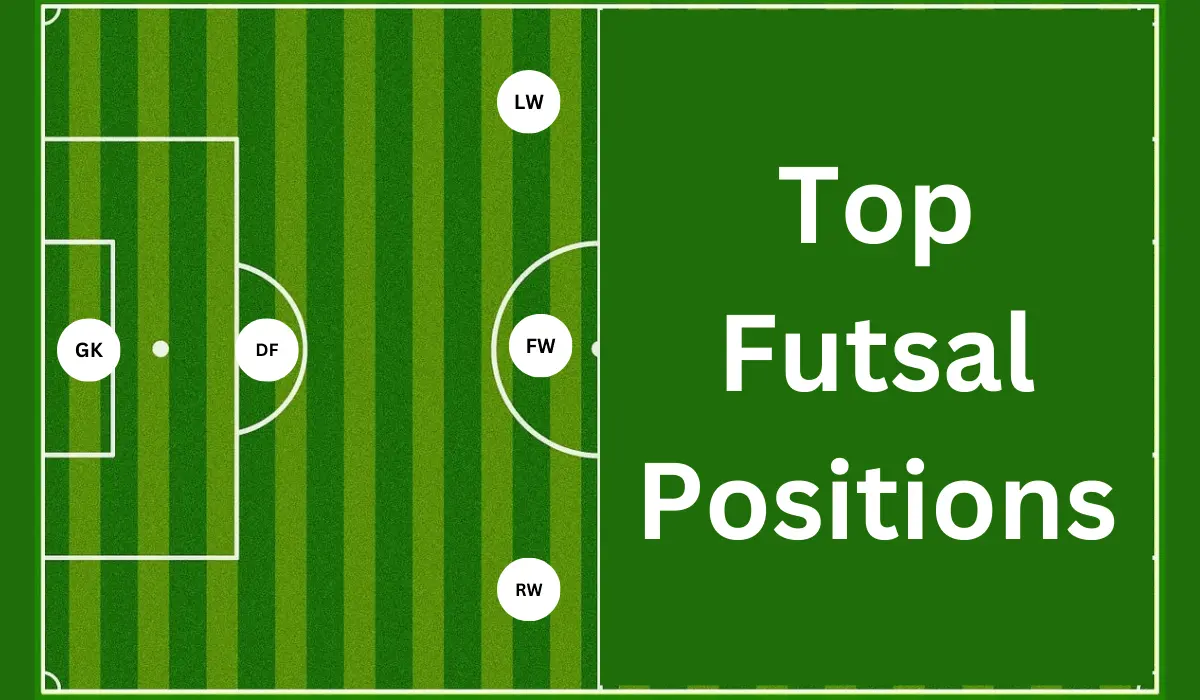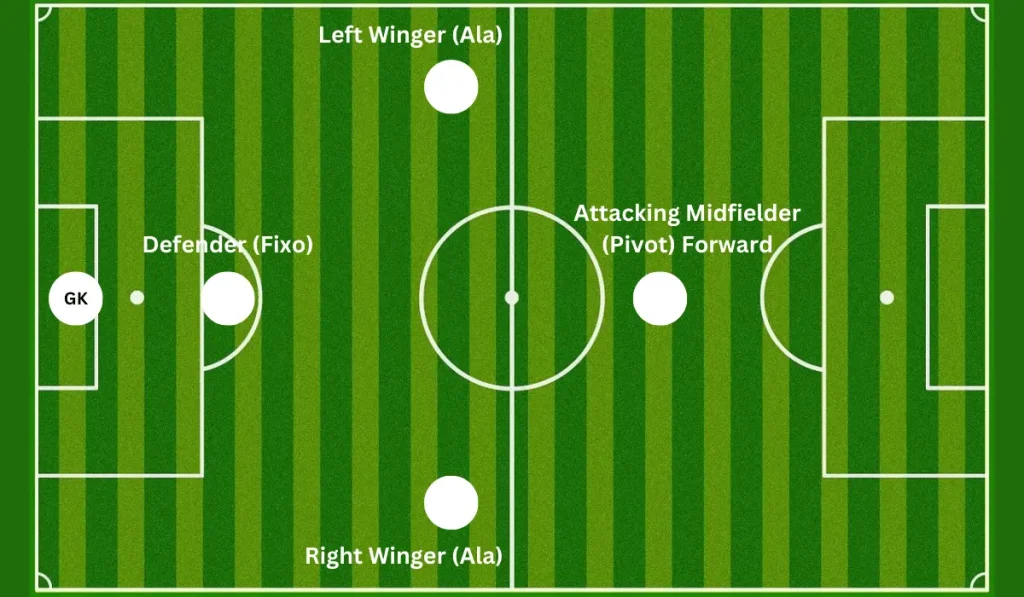Top 5 Important Positions in Futsal and Roles

FutsaL positioning is key so the top positions are very important. Each player in futsal has a specific job they need to do. This helps the team work together. The goalie has to make big saves. The defenders need to stop the other team from scoring. The wings run up and down the sides fast. The pivot is in the middle to be creative. And the captain leads everyone.
These positions let futsal teams play how they want. The positions give structure but the players can also move around. Teams with top players in the key roles will be very hard to beat. These top positions make great futsal teams stand out from normal teams.
To be successful in futsal, players must understand their roles and positions on the court and how they connect with teammates. This allows them to maximize space, create effective formations, and strategize attacks and defense in the best possible way.
Futsal Player Positions and Roles
Futsal is a fast-paced, dynamic variant of football played between two teams of 5 players each on a hard indoor court. While constant movement and interchangeability are integral aspects of futsal, certain positions and roles have emerged based on tactics and court geography.
Much like in football, futsal and indoor soccer teams require specialized players to take on key positions across the court to balance defense and attack. The goalkeeper acts as the last line of protection, while defenders provide security at the back.

Wingers operate up and down the flanks, supporting both ends of the play. The pivot or attacking midfielder provides creativity through the center. When performed well, these positions connect to provide structure, chemistry, and balance for futsal teams.
Having players who can excel in their specific roles helps optimize a team’s effectiveness on the court. Interchanging roles dynamically optimize space while maintaining team shape and chemistry. Identifying position-specific talented players elevates your futsal game.
The key positions in futsal each make unique contributions. But it is the combination of excellence across all positions and their role respectively. that truly elevates a futsal team game. If you have the optimal player positions for national teams your team will improve in a result in your team’s FIFA Rankings for futsal of the team improves.
Goalkeeper – The Most Important Man
The goalkeeper is the most crucial position in futsal tournaments, serving as the last line of defense with game-changing shot-stopping abilities. Their primary role is preventing goals by using their hands to catch or block shots in the penalty area. Sharp reflexes, agility, and bravery are key attributes.
Vocal communication is vital, with keepers instructing defenders on marking and offering leadership. Good distribution restarts attacks rapidly after saves. Within the area, keepers have just 4 seconds before releasing the ball and cannot pick up back passes.
Confidence with the ball at feet is needed to join attacks or provide an extra man advantage. But forays forward must be judicious, as the goal is left exposed. Regaining position quickly is essential if possession is lost.
Due to the condensed court, keepers are higher starting position and must be bold in confronting onrushing attackers. The attire includes a jersey, shorts, knee pads, and gloves for grip.
Coaches should assess shot-stopping, agility, distribution, communication, courage, and technical qualities. The best keepers provide calm confidence and concentration even when conceding goals. Their reliability reassures teammates.
The high-volume shots in futsal keep goalkeepers busy, so training must replicate intense game scenarios. Dedicated preparation is vital, as top-class keepers capable of match-winning saves provide a major advantage. Their impact often determines winning or losing.
Fixo (Defender)
Futsal defenders play a crucial role in protecting the goal. Their main duties are tight marking of opponents, delaying attacks, regaining possession, distributing the ball cleanly, providing defensive cover, and contributing to the attack.
Defenders must show excellent positional awareness, tactical intelligence, tackling accuracy, communication skills, concentration, patience, and discipline. Lapses can expose the goal so concentration is vital. Defenders jockey and track opponents while avoiding reckless dives.
Communication with the keeper and fellow defenders ensures proper coverage. If attackers evade, the defender must slow them until help arrives. Starting attacks through accurate passing to wings and midfield is key after regaining possession. Defenders also require composed possession skills when pressured.
Due to futsal’s dynamic nature, defenders must contribute to attack via overlapping runs and crossing. However, defensive cover must be retained. Defenders generally start on the edge of the penalty area but must adapt positioning intelligently during play.
Physically, defenders need pace, stamina, strength, and athleticism. Mentally, they require concentration, composure under pressure, and leadership ability. The organization of teammates and defensive shape are expected.
Standard futsal attire is worn, some opt for gloves. Training develops positioning sense, technique, tackling, and attacking contributions. Video review builds the ability to ‘read the game’.
The best defenders show calm authority and disciplined decisions. Their robust defense neutralizes threats while intelligent delivery and timely forays forward enhance attacks. A top futsal defender is invaluable.
Alas (Wingers)
The alas or wingers in futsal operate on the flanks and have a dual role in both attack and defense. Their non-stop running links play from back to front. Wingers need pace and stamina to tirelessly charge up and down.
Dribbling skills are vital to beat defenders in 1v1 situations out wide. Trickery and change of direction create space for crosses in the box. Combining passing moves with the pivot is key.
Tracking back to mark opposition wingers is crucial when not in possession. Wingers also provide width to stretch defenses in attack. Their constant involvement at both ends is demanding.
Positioning sense to know when to commit forwards and when to prioritize defense is important. Wingers facilitate scoring chances but must retain defensive duties.
Technical skills like close control while running, crossing, and swivel turns are essential for wingers. Their delivery into the box poses a major threat. Two-footed ability is an advantage to deceive defenders.
Wingers share a heavy workload and must be intelligent in link-up play. Connecting defense, midfield, and attack smoothly is critical to success. Fitness, flair, and flexibility make top futsal wingers stand apart, especially in top futsal leagues.
Pivot (Attacking Midfielder)
The pivot, also called the attacking midfielder, is the creative fulcrum of futsal teams. Their role is to link play between defense and attack with close control, nimble footwork, and accurate passing.
Operating predominantly through the center, the pivot aims to receive passes in pockets of space between defenders. Excellent close-quarters dribbling and ball manipulation in tight areas are vital.
The pivot is the central attacking conduit, bringing wingers and other players into the play. Their passing unlocks defenses while timely through balls release forwards.
Shooting ability is crucial as the pivot presents a constant goal threat. They can swivel and finish from any angle around the box. Long-range shooting over defensive walls is also expected.
Other duties include holding up the ball with back to goal to bring others into play. The pivot’s clever positioning and movement aim to pull defenders out of position.
Stamina, strength, and speed help pivots shake off tenacious marking. Flair and vision maintain attacking momentum. Defensive responsibilities like tracking opposition pivots are also required.
For youth players, mastering the intricacies of the futsal pivot role develops close control, passing range, shooting technique, off-the-ball movement, and tactical understanding.
Futsal Positions Strategy and Roles
While each futsal position has designated roles, the game allows for complete fluidity between the players. Intelligent teams will interchange positions and swap roles dynamically based on the situation.
For example, the pivot may drop deep to pick up the ball from the defense, allowing the fixo to make an overlapping attacking run. Or a winger can cut inside to the center, with the pivot moving wider. This flexibility and positional rotation is an important futsal strategy.
Futsal Rules, Roles and Formations
After examining futsal positions, it’s important to cover some key rules and formations that impact futsal strategy. Futsal is played between two teams of 5 players, one being the goalkeeper. Unlimited rolling substitutions are allowed, leading to constant high-tempo action on the field.
The game consists of two 20-minute halves on a compact indoor court around 25-42 meters long and 15-25 meters wide, with a small weighted futsal ball. Slide tackling is prohibited but shoulder challenges are permitted.
The most common formation is 3-1, with three outfield players and a dedicated goalkeeper. Teams can also arrange futsal formations like 1-2-1, 1-3-1, 2-2-1, etc. based on their strategy and player skills. There is no offside rule that allows attackers to go beyond defenders freely.
Other key rules include substitutions only during stoppages, accumulated fouls leading to direct free kicks, no goalkeeper pickup of backpasses, and a 4-second limit on restarts.
These rules combined with the indoor soccer formations shape the fast-paced, free-flowing nature of futsal requiring quick reflexes, passing, communication, and positional interchangeability.
Best Footwear for Futsal by Top Futsal Players
The best futsal players in the world rely on specialized futsal shoes to optimize their performance on the court. Futsal shoes are engineered for the fast, dynamic indoor game.
A grippy flat sole provides unmatched traction to sprint, stop, pivot, and change direction rapidly. The snug fit and premium materials like Kangaroo leather give players a glove-like touch and control over the ball when dribbling or passing in tight spaces.
The lightweight construction enhances agility while cushioning absorbs impacts from constant runs and high-intensity sharp twists and turns. Futsal shoes are very flexible with the foot for quick changes of direction and turns.
For elite futsal players like Ricardinho, and Falcao their futsal shoes act as the skin of their feet. The players’ close connection with the ball and fluent movements are aided by their best footwear.
Investing in top-quality futsal shoes like the Adidas Men’s Samba, SENDA Ushuaia Club, Joma Men’s Futsal Shoe, and Nike Street Gato is crucial for serious players to gain an edge. on your opponents. The optimized traction, fit, ball control, and cushioning let players perform futsal-specific moves and react quickly during the fast-paced game.
Having shoes designed specifically for the futsal court’s surface allows futsal stars to enhance their technical skills and be creative with their feet because the best shoes for futsal will allow them. Their footwork and flair are enhanced by futsal shoes built for the exact purpose.
Conclusion of Futsal Positions and Roles
And that’s a wrap!
We’ve covered all the key futsal positions and how they connect to create a cohesive, well-balanced team.
Whether you prefer being the courageous keeper, the creative pivot, the tireless winger, the sturdy defender, or the inspirational captain, each role makes specific contributions to the respective team.
Master your position through targeted training, but remember futsal requires all players to chip in attack and defense. With the fluid interchange of roles, communication is vital.
Keep up the hard work and remember the importance of specialized futsal shoes. With a dedication to your role and the right gear like grippy, responsive shoes, you’ll be ruling the court in no time!
